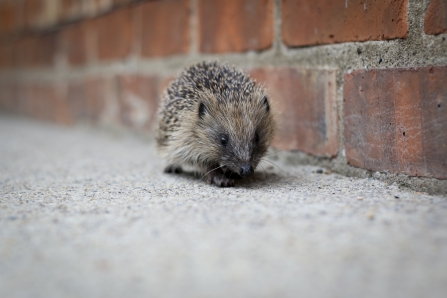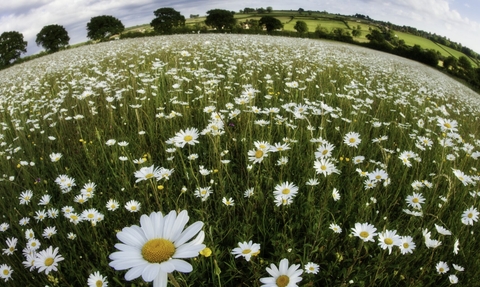
Hedgehog Heroes
An estimated 30% of hedgehogs have disappeared over the past decade. There are now fewer than one million left.
Once a common sight in our gardens, this spiny species is now declining rapidly across the UK. The reasons for the declines are not clear, but habitat loss and urban development – particularly the loss of hedgerows, habitat fragmentation and the intensification of agriculture – is to blame. Roads, garden pest control – including slug pellets – and the increasing use of impenetrable garden fencing is certainly contributing to the decline of our urban hedgehogs.
Be a Hedgehog Hero!
Everyone can take steps to protect the UK's most beloved species. Whether you have a garden or use a green space, follow these tips to become a hedgehog hero and help them thrive!
Top Tips
Provide good food
Leaving food out for hedgehogs can help them during cold snaps and help them reach a healthy hibernation weight. A meaty dog or cat food (not fish flavoured), dry cat biscuits, unsalted peanuts and mealworms are firm favourites. Please don't give hedgehogs bread and milk - it's very bad for them as they are lactose intolerant. You can put food in a crate or box to prevent other critters from polishing it all off!
Garden Wild
Leaving patches of long grass will attract insects and other wildlife. Create a variety of habitats and keep your garden green. Paving and decking over gardens reduces ‘hog habitat.
Choose insect- attracting plants
Attracting insects - including bees, butterflies and other pollinators - does wonders for your garden. Not only will it help your plants to thrive but they will provide food for hedgehogs and a host of other birds and beasts! .
Connect your garden
Habitat loss is a major cause of hedgehog declines. As urban gardens are increasingly fenced in and cut off, hedgehogs are unable to move between them to find food and mates. A small hole 13cm x 13cm (the size of a CD) will connect your garden with others.

Credit @Tom Marshall
Control pests carefully
Slug pellets can kill hedgehogs. For some effective alternatives suggested by Hedgehog Street, click here.
Give a 'hog a home
Providing hedgehogs with a home througout the year will encourage them to take up residence in your garden. You can purchase an affordable and effective Hogitat here. If you'd like to build your own, there are many guides out there for all manner of mansions - check out this advice from Hedgehog Street, this guide from the British Hedgehog Preservation Society, or build this rustic house from Gardeners World.
Stack wood
This encourages a rich feast of earwigs, centipedes and woodlice, perfect food for 'hogs! Woodpiles will also provide refuges for wildlife to hide in.

Credit: Tom Marshall
Build a ‘bug hotel’
Stuff your hotel with lots of straw and hollow plant stems and earwigs, woodlice and centipedes will soon make it their home. They're perfect food for hedgehogs and other lovely garden wildife including nesting birds. Follow these tips from Wild About Gardens to produce the perfect pad.
Create nesting opportunities
Leave prunings and leaves in a wild corner for hedgehogs to use when makingnests. Hedgehogs love apple and cherry leaves, and hawthorn and honeysuckleprunings make good structural supports.
Hedgehogs and other wildlife may nest under sheds, patios and pavings. It's important to check these structures carefully for any sleeping critters before removing or relocating them.
Build a hedgehog-friendly pond
A pond is the single most important thing you can do for wildlife in your garden. However, ponds can also be dangerous for hedgehogs if it falls in and can't get out! Incorporate a sloped gravel beach or put a ramp into any pond or water body in your garden to allow hedgehogs and other animals to climb out if they take a dip.
Leave a leaf pile
Damp leaves provide the perfect shelter for ground beetles, worms and other tasty bugs. Leaves also provide the perfect nesting material for hedgehogs, which can move their bed several times throughout winter.
Mulch beds with garden compost
This encourages plenty of earthworms, woodlice and beetles as it begins to rot down. What's more, rotted leaf litter makes perfect plant food and will help your garden thrive.
Compost carefully
Hedgehogs love a good compost heap, so take care when turning with heavy equipment. Spread the heap before October/November ahead of hibernation.
Bonfires
Everyone loves Bonfire Night, but be aware that this is the time when hedgehogs hibernate and a bonfire can make a perfect nest. Before lighting, rebuild bonfires to allow hedgehogs to relocate.
Strimmers
Strimmers severely hurt hedgehogs. Before cutting overgrown areas, check for hedgehogs and other wildlife. Beat the top of vegetation lightly to scare away hiding wildlife.
Netting & litter
When protecting your plants, make sure netting is 1ft off the ground to prevent hedgehogs and other animals from becoming entangled. Tidy up, as litter can be lethal. Cut in half the plastic rings found around cans, and pinch cans shut to help wildlife. You can also play a part in wider conservation by recycling effectively.
Help us, help you, help hedgehogs
We joined with the Friends of Brandwood End Cemetery and the Parks Ranger Service to help hedgehogs in a corner of South Birmingham. We surveyed this fascinating site, collected records of sightings in the neighbourhood, improved natural spaces within the cemetery to encourage hedgehogs and helped local residents, schools and community groups make similar improvements to their gardens.
Together, school children at St Alban's Catholic Primary School and Woodthorpe Junior and Infant School, and community film maker Rachel Gillies made this short film to document the work taking place at Brandwood End Cemetery, and show you how you can help hedgehogs too:
Help for Hedgehogs (https://vimeo.com/220434379)
Credit: Rachel Gillies
Are you part of a community group, school or manage a green space where you'd like to encourage hedgehogs? Get in touch and we can help you be a hedgehog hero too.
COMING SOON Log your 'hog!

Traditionally managed wildflower meadow with Oxe-eye dasies (Chrysanthemum parthenium), Hardington Moor NNR, Somerset, England, UK Taken using fisheye lens - Guy Edwardes/2020VISION



